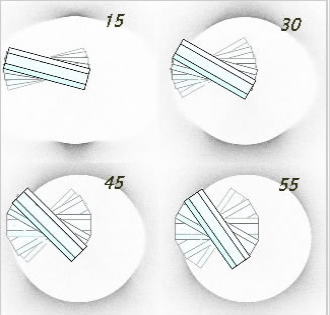22° Circular Halo
Understanding the 22° Circular Halo
Atmospheric optics phenomena can be truly mesmerizing, and one of the most intriguing sights is the 22° circular halo. This ethereal halo is often associated with randomly oriented crystals, but it is important to note that they are not the sole source of this phenomenon. In fact, what truly matters are crystals that are "poorly aligned," meaning they have a significant distribution of tilts about their equilibrium positions.
To gain a deeper understanding of the 22° circular halo, we can turn to HaloSim simulations that illustrate the effect of increasingly poor alignment of column crystals. These crystals, found drifting downwards in clouds with their prism axes nearly horizontal, play a vital role in creating this captivating optical display.
Let's explore some key factors that contribute to the formation and appearance of the 22° circular halo:
Crystal Tilts and Halo Appearance
-
Maximum tilts of 30-45° result in a halo that is commonly observed. This halo appears circular but exhibits variations in brightness at the top and bottom regions. The distinct contrast in brightness adds an enchanting touch to the overall spectacle.
-
Slightly greater tilts, beyond the 30-45° range, can produce halos that appear more uniform in their brightness distribution. These halos may lack the pronounced variation seen in the aforementioned halo, but they still possess their own unique allure.
Sun Position and Halo Uniformity
- The position of the sun plays a significant role in determining the required crystal tilts for a near-uniform halo appearance. When the sun is positioned higher in the sky, the tilts needed for nearly uniform halos become smaller. This means that as the sun ascends, the crystals must align more precisely to create a halo with a consistent brightness throughout.
Crystal Alignment in Clouds
-
Column crystals, which are elongated ice crystals with prism axes nearly horizontal, are particularly influential in the formation of the 22° circular halo. These crystals tend to drift downwards within clouds, contributing to their alignment and subsequent impact on the halo's appearance.
-
The alignment of column crystals is crucial for the formation of the 22° circular halo. When these crystals are poorly aligned, meaning they have a wide distribution of tilts about their equilibrium positions, they create the conditions necessary for this captivating atmospheric phenomenon to occur.
Further Exploration
The study of atmospheric optics continues to captivate scientists and enthusiasts alike. While the 22° circular halo is just one of many breathtaking optical displays, it serves as a reminder of the intricate interplay between light and the natural world. By delving deeper into the characteristics of crystal alignment and their impact on halos, we can unlock even more insights into the mysteries of atmospheric optics.
Remember, nature's wonders are not limited to textbooks or computer simulations alone. Observing the sky with an open mind and a keen eye can lead to unexpected discoveries and a profound appreciation for the beauty that surrounds us. So, next time you find yourself gazing at the sky, keep an eye out for the elusive 22° circular halo and let its ethereal presence inspire your curiosity about the wonders of our atmosphere.

Halos formed by column crystals with large tilts. The tilts are uniformly distributed and the numbers are the maximum tilt. The sun was 30� in the simulation.
Randomly oriented crystals are often said to be the source of 22� halos. They could produce them, but they are not essential.
What are needed are "poorly aligned" crystals, ones with a rather large distribution of tilts about their equilibrium positions.
The HaloSim simulations at right show the effect of increasingly poor alignment of column crystals. These tend to drift downwards in clouds with their prism axes nearly horizontal.
Maximum tilts of 30 - 45� give a halo seen very often, circular but brighter at the top and bottom.
Slightly greater tilts give reasonably uniform halos.
When the sun is higher the tilts needed for nearly uniform halos get smaller
Note: this article has been automatically converted from the old site and may not appear as intended. You can find the original article here.
Reference Atmospheric Optics
If you use any of the definitions, information, or data presented on Atmospheric Optics, please copy the link or reference below to properly credit us as the reference source. Thank you!
-
<a href="https://atoptics.co.uk/blog/22-circular-halo-2/">22° Circular Halo</a>
-
"22° Circular Halo". Atmospheric Optics. Accessed on May 6, 2024. https://atoptics.co.uk/blog/22-circular-halo-2/.
-
"22° Circular Halo". Atmospheric Optics, https://atoptics.co.uk/blog/22-circular-halo-2/. Accessed 6 May, 2024
-
22° Circular Halo. Atmospheric Optics. Retrieved from https://atoptics.co.uk/blog/22-circular-halo-2/.